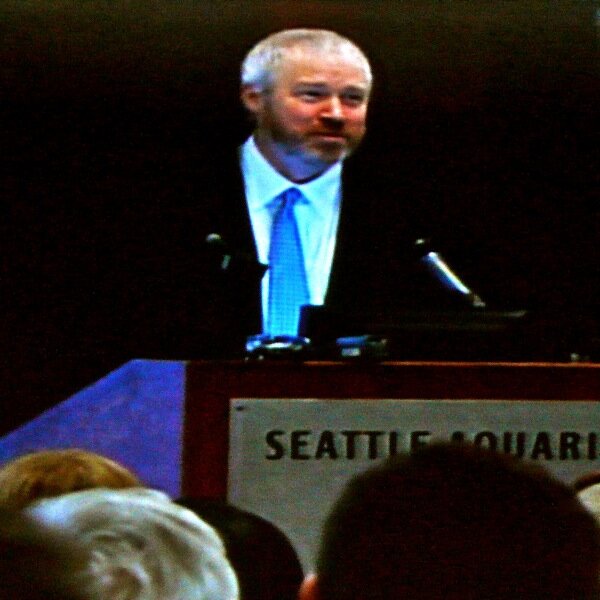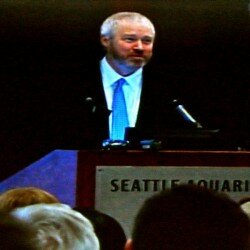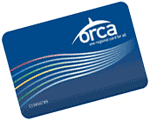
With Prop 1 going down to defeat, 60 percent of voters against, a lot of political diviners were rummaging through entrails trying to figure out why Seattle had turned its back on a forward-thinking transit initiative. “Here’s the proposed breakdown,” said KING 5, listing out how the Prop 1 money would be spent:
- roughly half the money, about $100 million, is for mass transit.
- $59 million for fixing streets and potholes.
- $23 million for pedestrians and bikes.
Publicola weighed in: too regressive, plus McGinn’s negatives. Seattlepi.com: pushback to McGinn’s extremist clique. Seattle Times: like we’ve been saying all along, McGinn is the Antichrist. Seattle Transit Blog had three takes: a) all of the above, b) weak messaging, c) no sexy win. McGinn: MOAR STREETCARS!
I don’t know what people were thinking, really, and I doubt anyone else does, either. It is true that both the city and the King County Council had already increased car tab fees to $40, so this latest $60 increase would have created $100 tabs.
But on the face of it, I’m happy enough that people said no, even it it does put a temporary stick in the spokes of new transit. Seattle’s political leadership has developed an unsettling fondness for an “Or the puppy gets it!” strategy when it comes to extorting money from taxpayers. Again and again, basic infrastructure is neglected until a crisis is reached, at which point a huge bill is presented.
That’s not responsible governance. But even worse, the huge bill isn’t the end of it. I’ve written before about Seattle’s Bridging the Gap levy, a $365-million, deferred-maintance catch-up that after four years has left us…with a $578-million backlog of road repair. Actually, you may want to sit down, because that’s just deferred arterial maintenance. Add in bridges and regular streets, and the bill becomes billions.
In that context, Prop 1’s $59 million doesn’t seem terribly proportionate, does it?
But our government is perfectly happy to look the other way on this. The cost of doing something about it is so massive that it’s become crazy to talk about doing something about it. Instead, you get Prop 1’s finger in the 17th Street Canal levee, as it were. Fixed!
Then win or lose, the conversation turns to strategy and messaging, and the looming, titanic failure of our city infrastructure goes undiscussed. Basic infrastructure is what city government is for–yet the City of Seattle consistently has tried to wriggle out of having to pay for maintenance out of its operating budget (it’s not just roads–it’s the same with parks, with the Seattle Center), preferring instead to use the ballot box as an ATM.
Nothing about ongoing maintenance requires this. These are line items, foreseeable expenses. I don’t doubt that the task of budgeting is an unenviable one, but everything else this city provides rests upon its infrastructure. A mayor and a city council that don’t realize that are worse than useless–they’re damaging to the future.
I don’t blame this mayor or this city council for the situation we find ourselves in, but the spending problem here is not going to be solved with Propositions.
UPDATE: Here is the City Council’s press release on their budgeting efforts. Just at a glance, what percentage of this deals with Seattle’s ailing infrastructure? Do you see any recognition that the city’s foundation is crumbling?
Seattle City Councilmembers present 2012 budget balancing package
Final budget vote scheduled for November 21
Seattle – Today the Seattle City Council presented their proposed changes to the 2012 budget with a balanced package of cuts that preserve essential services. The Council focused on maintaining funding for public safety, health services and food programs, and housing for the most vulnerable.
“Operating the leanest government possible while maintaining critical services was our overarching goal. We believe we have reached that goal,” stated Councilmember and Budget Committee Chair Jean Godden. “There is no doubt that we will feel the impacts of state budget decisions whatever they may be.”
Council utilized community feedback as a key indicator of programs and services to be preserved. For example, the Council will undo a merger of the Office of Housing and Office of Economic Development proposed by the Mayor, based on input from Community stakeholders. In their review of the Mayor’s proposal, the Council was able to identify staffing efficiencies that could be implemented that will result in ongoing savings of more than $400,000 each year while maintaining the two separate offices.
“We are reinventing government to be as efficient and effective as it can be,” said Council President Richard Conlin, Chair of the Regional Development and Sustainability Committee. “However, we cannot sustain this budget if the state cuts human services and public safety programs and leaves cities with the responsibility of picking up the pieces.”
Councilmember Mike O’Brien, Chair of the Seattle Public Utilities and Neighborhoods Committee added, “This budget presented us with many challenges and difficult choices, but I believe we reaffirmed the City’s commitment to Seattle’s neighborhoods. From the Safe Parking Pilot Program in Ballard to keeping community centers open to preserving support for our beloved p-patches, Council stands by our neighborhoods and their priorities.” Working with community partners, such as faith-based organizations and local food providers, Council was able to maximize opportunities through joint investments to fund these programs.
Throughout the budget review process this year, Councilmembers heard a steady request for additional funding to address a reported surge in the need for shelter and housing for homeless families with children in Seattle. Providers have reported increasing numbers of families seeking such assistance due to the economy and decreased support from other levels of government.
To meet this demand, Councilmembers agreed to a funding package that expands capacity along the spectrum of services, from shelter or temporary housing to permanent housing for homeless families with children. The intent is to review actual use of the money by the end of the second quarter of 2012 to evaluate whether the demand for family-focused support materialized at the level expected. The additional funding totaled $435,000 and will serve at least 47 families.
“The Council adopted Resolution 31292 in May which stated the intent to better meet the long-term housing and immediate survival needs of those without shelter or housing. In the Council’s budget proposal, we increased funds for shelter and housing services for homeless families with children by $435,000. This is a significant step toward the goal that no family be unsheltered by the end of 2012,” stated Councilmember Nick Licata, Chair of the Housing, Human Services, Health and Culture Committee.
To address neighborhood challenges, the Council designated $376,000 to a Precinct Liaison Program within the City Attorney’s Office. The precinct liaison attorneys will work closely with police officers and the Seattle Police Department leadership to address a variety of community and neighborhood problems, including nuisance properties, nightlife issues, graffiti abatement, alcohol impact areas, and crime hot spots.
“We focused on how we address public safety challenges in a time of very limited resources,” said Councilmember Tim Burgess, Chair of the Public Safety and Education Committee. “We beefed up early interventions to prevent crime by expanding the Nurse Family Partnership program to reach more low-income, first-time mothers. We joined with City Attorney Pete Holmes to reengineer the precinct liaison program to address chronic crime hot spots. We directed the Police Department to update the Neighborhood Policing Plan to match current officer staffing levels.”
“We funded a body-mounted camera pilot project for our police officers to enhance public safety and accountability, created a new office to assist the successful integration of immigrants and refugees into our City and provided additional help in the community for uninsured residents to receive medical and dental care,” said Councilmember Bruce Harrell, Chair of the Energy, Technology and Civil Rights Committee. “These actions help to ensure that our City continues down the path of achieving our social justice goals.”
Council is also responding to the growing concern regarding quality of life issues, such as improving health care accessibility for the uninsured, safety along Third Avenue and other pedestrian and transportation improvements.
“The City Council is committed to improving safety of transit riders and pedestrians in downtown Seattle. Since light rail began operations, the number of pedestrians and transit riders using Third Avenue has significantly increased. Through the Council’s Third Avenue Initiative, the City will develop a plan that may include more regular cleaning, improved lighting and development of a pilot ‘hot spot’ policing initiative for certain blocks along the Third Avenue Transit Corridor,” stated Councilmember Tom Rasmussen Chair of the Transportation Committee.
Councilmember Sally Bagshaw, Chair of the Parks and Seattle Center Committee stated, “I am very pleased with City’s effort to balance this budget. We have made cuts while addressing the needs of our neighborhoods, as well as caring for neighbors in need.”
“I’d like to thank Councilmember Godden and my fellow colleagues for crafting a budget that invests in what matters,” said Councilmember Sally J. Clark, Chair of the Committee on the Built Environment. “Budget challenges only get tougher from here, but I’m hopeful we can partner with our friends in Olympia to minimize the impact to Seattle residents.”






